Hanashobu
Display in Japan
Hiroshi Shimizu
|
| Improvement of hanashobu, which in the West is
called the Japanese iris, was first undertaken in Japan, and there are now more
than two-thousand named cultivars in my country. The development of hanashobu
has been directly related to its display. To understand the development of
hanashobu it is necessary to understand this relationship, which I shall
explain. |
 |
| Fig.1 View of the Kodakaen at horikiri,a colour print of Hirosige |
Garden Display
When
Japanese people want to appreciate the beauty of hanashobu they usually visit
hanashobu gardens when the irises are in bloom. There are at present more than
two hundred hanashobu display gardens spread over the Japanese archipelago.
More than two million people visit these gardens each year.
Early in the
19th century several gardens at Horikiri, Located about six miles east of the
center of Tokyo, became famous for hanashobu displays. George M. Reed of the
Brooklyn Botanic Garden visited these gardens in 1930, and wrote a very good
article describing them,"The Iris of Japan" which appeared in the
Bulletin, No.40, of The American Iris Society.
The most
famous of the hanashobu gardens at Horikiri was Kotaka-en. Hiroshige, the great
ukiyo-e a painter, executed a beautiful woodblock print showing the hanashobu
on display in this garden(Fig.1). Three viewing pavilions and a well developed,
trained pine tree are in the center of the picture, and an artificial hill is
on the left. From the elevation of this hill, visitors could get a good view of
the hanashobu just below.
In the lower
garden about fifty different varieties of hanashobu were grown. They were grown
in rows of variable length, and usually only one kind to a row. But each
variety was repeated at several different places in the garden. The visitors
were admitted to the garden upon the payment of a small fee, and they sat in
one of the viewing pavilions to enjoy the flowers.
The
hanashobu plantings were surrounded by elevated banks or levees, and the
visitor walked on the banks, which held water in the beds, to appreciate the
flowers. The design of this garden leads the visitors to see the irises only
from above !
There are
two reasons the kotaka-en garden was designed in this manner. The first reason
was to protect the owner's house and family from floods. Flood disasters
occurred often in the Horikiri area. The owner's house, not shown in Fig.1, was
also built on an elevation for this reason. The second reason for the Kotaka-en
design is that Japanese peoples like natural scenic beauty. The open vista seen
from the top of the hill and from the pavilions was lovely. Japanese garden
design principles call for the surrounding wood, river and mountain(Shukkei) to
be incorporated into a total scenic view.
The
appreciation of Hanashobu in the open vista, looking down upon the flowers,
gave impetus to the development of a new flower form, the "horizontal
form", in the Tokyo region. Varieties in this form are very strong and
resistant to the wind and rain. We call these types of hanashobu the "Edo
types" after the old name for Tokyo.
|
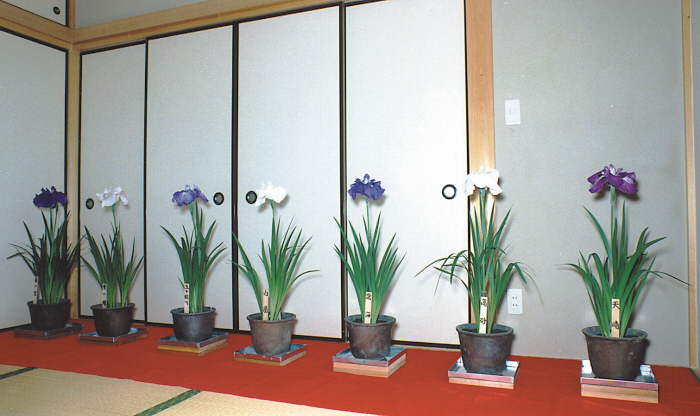 |
| Fig.2 Kumamoto indoor display |
Indoor
Display
There are
three quite distinct types of traditional indoor display for hanashobu in
Japan. The first I will describle is Kumamoto indoor display, which is
practiced by the Kumamoto Mangetu Kai. Kumamoto is the name of reagion in
south-eastern Japan on the island of Kyushu. The Mangetu Kai, which means
"Full Moon Society", was organized for the development and
appreciation of hanashobu, and its annual meeting was held at the time of the
full moon in June.
The unique
method of display in Kumamoto entails showing the irises in pots. The hanashobu
bloom season in Kumamoto is frequently beset with heavy rains, which lead to
growing the irises in pots. Gradually, too, rules were developed for the
display for irises inside the house. Pods were about 24 cm in diameter, and
flower stalks were about 90 cm in height (Fig.2). Seven to nine plants were
arranged along the wall side of the main room. One or two irises were displayed
in the tokonoma, a special alcove designed for displaying objects d'art,
paintings and plants appreciate to the season. The irises displayed in the
tokonoma had flower stalks smaller than those on display along the wall.
To the Kumamoto Mangetsu Kai the inner sprit was
more important than the form in the display. The heart of the display lies in
the "selfless manner" in which the host serves the guests. Therefore,
the host did not put stalks of his new varieties in the tokonoma, a place of great
ritual importance in Japan. Likewise, when the host arranged the potted irises
along the wall of the room, he put the guest's varieties in the center of the
row.
When the
guests appreciated the irises, they sat upright and bowed to them. This marked their
respect for the flower. Next, the guests stood up and examined the shape and
size of the style arms. They liked large and strongly formed style arms, and
very much disliked small or poorly formed style arms. Because they believed
that the flower's "mind" is in the style arms, being in the center of
the flower, the style arms must be large and "right" as the heart of
a human being should be.
After
appreciating the irises on display, guests talked with the host about
cultivation and the shape and color of irises on display, but there was no
"flower contest." Thinking that each variety has its own personality
and virtue, the individual characteristics must be respected. Competition would
be disrespectful.
These
Kumamoto irises devotees liked the arched flower form, which resembles the
shape of Mt.Fuji. This was because they viewed the iris from the side, rather
than from the top. Improvement of their varieties was directed to the creation
of varieties suitable for display in a Japanese style room. We call their
irises the "Higo type" after the old name of Kumamoto. Varieties of
the Higo type are especially well liked by many Japanese hybridizers.
|
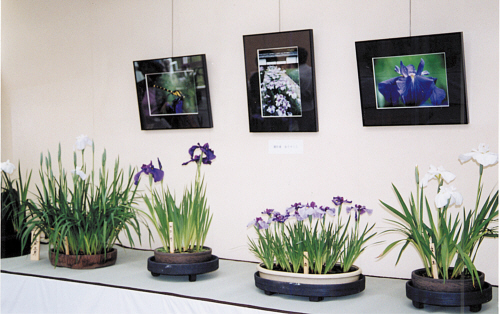 |
| Fig.3 Tokyou dwarf plant disply |
The second
type of indoor display I will address is the Tokyo dwarf plant indoor display.
This is a method of pot culture and display devised by Mr.Ichikawa about 1930.
Mr.Ichikawa used a flat pot about 30 cm in diameter and 3 cm deep to cultivate
and display hanashobu. Usually ten to twenty rhizomes are planted in the pot
during bloom season. The following year these plants will bloom seven to
fifteen flowers.(Fig.3)
The essence
of the art of this unique method of cultivation is in skillfully controlling
grows. The amount of fertilizer and water are carefully regulated, and the pot
is moved in response to seasonal and weather changes. Care is taken to protect
against disease and insect pests.
To totality
of flowers, leaves and pot produce a natural elegance of form pleasing to the
eyes. The ability to succeed with this method can be said to spring from the
resourcefulness of Mr.Ichikawa who, in his love of nature beauty, tried to
bring it closer to his life.
The suitable
varieties for this method of display are not miniature types with smaller
flowers, but rather smaller growing Edo and Ise cultivars. Undoubtedly this
form of display shows the influence of bonsai. At present Mr.Noboru Kobayashi,
who lives in Tokyo, avidly cultivates and displays his irises in this way. |
 |
| Fig.4 Ise indoor display |
Ise, is the
distinct in central Honshu where the Grand Shrines dedicated to the ancestors
of the imperial family are located, and which has close ties to Kyoto. A unique
type of hanashobu and a unique type of iris originated in Ise, and this is the
third type of indoor iris display I will discuss.
At the
beginning of the 20th century, cultivation of irises for use in the unique Ise
display was rather widespread in the Ise district. Popularity of this display
style declined, however, and it seems that it is no longer practiced in Japan.
As a result, many details of the Ise display remain unclear. Fortunately, the
late Dr.Hirao illustrated the Ise style in his book Hanashobu(Kashima
Publishing Co.,Japan,1959). Moreover he provided a short comment about Ise
display in another of his book, The Japanese Iris(Asahi Shinbun publishing
Co.,Japan,1971). (For those who have access to this book, it is noted that the
comment is, regretfully, written only in the Japanese language.)
In the Ise style, potted flowers were displayed in
front of a folding screen or a curtain in a Japanese style room(Fig.4).
Twenty-seven plants were arranged in three ranks, nine plants in each rank. The
person making this display gave great care to flower color, and the height of
the flower stalks and leaves had to be about the same. A low screen in front of
the first rank was used to hide the pots in which the irises were growing.
Upon viewing
and appreciating an Ise display, a guest would say to the host: "All the
falls are sufficiently drooping downward." These words were the highest
form of praise one could give to an iris display in Ise.
The unique
"Ise type" of Japanese iris was developed for this display. All Ise
irises are single, the height of the flower stalks and leaves are about the
same, and the falls droop downward. I think that the characteristics of Ise
varieties, even more than those of Higo varieties, were influenced by the fact
they were developed for indoor appreciation. Consequently, Ise varieties have
shorter flower stalks than Higo varieties. Usually they are 70 to 90
centimeters in height. The shortness of stalk was one of the reasons the potted
plants needed to be put on a flower stand for display.
|
|
The
Japanese Mind and Hanashobu
Several years ago I contributed an article to
the Bulletin of The American Iris Society and the British Iris society Year
Book entitled "Iris Hybridizers in Japan." Referring to the Japanese
people, I wrote "When we look at flowers, we see the beauty of nature
through the flowers ." Its spirit is suggested by the Tokyo dwarf plant
indoor display. The flower, green leaves and soil in the flat pot symbolize or
reflect the forms and features of a hanashobu garden landscape. When a Japanese
person looks at it, his mind visits a large hanashobu garden and "takes a
rest" there. His mind is always hoping for harmony with Nature. This
spirit led to the creation of many hanashobu gardens and also to the creation
of the Tokyo dwarf plant indoor display.
On the other hand, the spirit of
Kumamoto("each flower has its own personality") is important to the
Japanese also. Japanese naturalistic religion, Shinto, grew out of the everyday
life of the Japanese people in primitive times. All natural objects and
phenomena were considered as having their own gods(kami). Today the majority of
Japanese people have no interest in the tenets of Shintoism, but they
nonetheless often sense that natural objects have distinct personalities. This
Japanese characteristic has contributed to the various flower forms developed
through iris hybridizing.(Fig.5)
The reverence for Nature is an emotional and
nonrational influence on the Japanese mind. At the same time, Japanese through
is marked with an insular prejudice, stemming from the relative isolation and
freedom from foreign invasion our nation experienced for many generations. This
insular prejudice has prevented the Japanese from developing universal concepts
so useful for international cooperation. The insularity of Japanese through has
directed the Japanese mind toward the inner spirit rather than toward universal
precepts. It is this inner direction of the Japanese mind that is reflected in
the elegant ritual of tea ceremony and in the Kumamoto indoor display of
Hanashobu.
The development of the unique characteristics
of Edo, Higo and Ise hanashobu varieties and the different display method
associated with these three distinct hanashobu types are creative art forms
which attempt to express the unique esthetic sense of the three Japanese
regions.
Dr.Shuichi Hirao, in his book The Japanese
Iris, observed that the characteristics of Edo hanashobu may be likened in their
smart, sophisticated air to the merchant culture which dominated Tokyo for so
long. The Higo hanashobu have the solemn dignity of the daimyo, the feudal
lords of pre-modern Japan. Ise hanashobu have the gentle grace of young women
of noble birth.
I think that the breeding of plants and the
manner in which plants are displayed reflect the culture in which the plantsman
lives. Unique cultural characteristics have their origin in centuries
past.
|
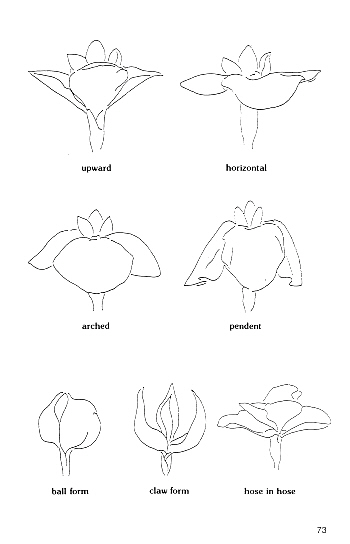 Fig.5 Flower form in Hanashobu Fig.5 Flower form in Hanashobu |
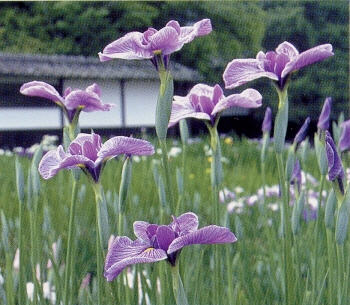 |
| Edo type(horizontal) |
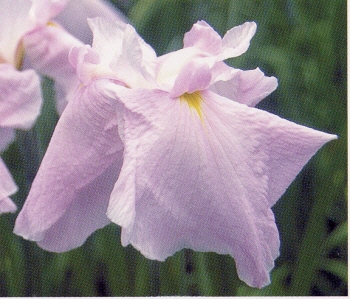 |
| Ise type (pendent) |
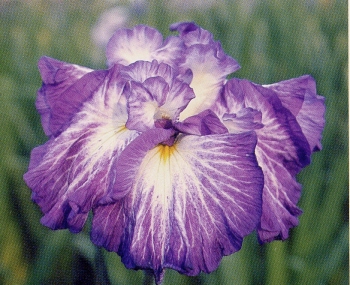 |
| Higo type(arched) |
|
 |